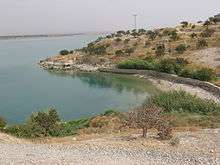Zeugma (Commagene)
Zeugma (Greek: Ζεῦγμα) is an ancient city of Commagene; located in modern Gaziantep Province, Turkey. It was named for the bridge of boats, or zeugma,[1] that crossed the Euphrates river at that location.[2] Zeugma Mosaic Museum contains mosaics from the site. One of the largest mosaic museums in the world.
Ζεῦγμα | |
 Parts of Zeugma have become submerged in the Euphrates River since the construction of the Birecik Dam | |
 Shown within Turkey | |
| Location | Belkis, Gaziantep Province, Turkey |
|---|---|
| Region | Commagene |
| Coordinates | 37°3′31″N 37°51′57″E |
| Type | Settlement |
| History | |
| Builder | Seleucus I Nicator |
| Founded | 300 BC |
| Site notes | |
| Condition | Partially submerged |
History
Zeugma was founded as Seleucia by Seleucus I Nicator in the early 3rd century BC on the site where he had the first bridge over the Euphrates built.[3] In 64 BC, the Romans controlled the city. Zeugma was of great importance to the Romans as it was located at a strategically important place. Up to 70'000 people shall have lived in the city, and it became a center for the military and commerce for the Romans.[2] In 253 AD, it was destroyed by the Sassanids, but was later rebuilt.[3]
In late antiquity, Zeugma was a diocese, but the place seems to have been abandoned in the 7th century due to Persian and Arab raids. Arabs lived there temporarily in the Middle Ages, and in the 17th century the Turkish village of Belkis was built near the ruins.
Today
Zeugma has been on the UNESCO World Heritage Site tentative list since 2012. Extant archaeological remains at the site include "the Hellenistic Agora, the Roman Agora, two sanctuaries, the stadium, the theatre, two bathhouses, the Roman legionary base, administrative structures of the Roman legion, the majority of the residential quarters, Hellenistic and Roman city walls, and the East, South and West necropoles."[4]
Three large glass mosaics were discovered at Zeugma in 2014, including one depicting the nine muses.[5]
In February 2020, it was reported that the Zeugma Mosaic Museum attracted a record 340,569 visitors in 2019, according to the Turkish Culture and Tourism Ministry.[6]
Gallery
 Zeugma The lake
Zeugma The lake Zeugma Excavations
Zeugma Excavations Zeugma Excavations and dam
Zeugma Excavations and dam Zeugma The dam nearby
Zeugma The dam nearby Zeugma Excavations
Zeugma Excavations Zeugma Excavations
Zeugma Excavations Zeugma Excavations
Zeugma Excavations Zeugma Excavations
Zeugma Excavations Zeugma Excavations
Zeugma Excavations Zeugma Excavations
Zeugma Excavations Zeugma Excavations
Zeugma Excavations Zeugma Excavations
Zeugma Excavations
References
- ζεῦγμα. Liddell, Henry George; Scott, Robert; A Greek–English Lexicon at the Perseus Project.
- "Museum of Roman Mosaics to Open in Turkey". www.luxurytravelmagazine.com. Retrieved 2020-03-28.
- "Remarkably Pristine Ancient Greek Mosaics Uncovered in Turkish City of Zeugma". mymodernmet.com. 24 November 2014.
- Centre, UNESCO World Heritage. "Archeological Site of Zeugma". UNESCO World Heritage Centre. Retrieved 2020-05-05.
- "Stunning Mosaics Uncovered in Ancient City of Zeugma | Archaeology | Sci-News.com". Breaking Science News | Sci-News.com. Retrieved 2020-05-05.
- AA, Daily Sabah with (2020-01-22). "Record number of tourists visit Turkey's Zeugma Mosaic Museum". Daily Sabah. Retrieved 2020-05-05.
Further reading
- ICOMOS Heritage at Risk 2001/2002: Zeugma, Turkey, Icomos Heritage at Risk 2001/2002.
- Özgen Acar (September–October 2000). "Troubled Waters". Archaeology Magazine, Volume 53 Number 5.
- Stephen Kinzer (July 3, 2000). "A Race to Save Roman Splendors From Drowning". The New York Times.
- Lisa Krause (February 2, 2001). "Website Pulls Together the Strands of Turkey's Past". National Geographic News.
- "Museum of Roman Mosaics to Open in Turkey". Luxury Travel Magazine.
- Kennedy, David. The Twin Towns of Zeugma on the Euphrates: Rescue Work and Historical Studies (Journal of Roman Archaeology Supplementary Series). Portsmouth, RI: Journal of Roman Archaeology, 1998.
External links
| Wikimedia Commons has media related to Zeugma. |

- "Zeugma, A Roman Town in Anatolia", a short documentary video
- Zeugmaweb.com
- Pictures of the Zeugma site
- Zeugma at Livius.org, article and photos
- BBC: The Secret Treasures of Zeugma
- UWA Classics and Ancient History Research: Zeugma on the Euphrates
- Gaziantep Archaeology Museum
- Some photos from the Zeugma Museum (Gaziantep, Turkey)
- Description of Zeugma on Gaziantep website